Seminar 8. Territorial varieties of the english language
TOPICS FOR REPORTS:
1. RP (Received Pronunciation)
2. Southern English Accents
3. Northern and Midland Accents
4. Welsh English.
5. Scottish English.
6. Northern Ireland English.
7. American English
a) The Eastern type
b) The Southern type
c) General American (GA).
Optional:
8) Australian and New Zealand variant
9) South African English
HOME PRACTICE.
EXERCISE 1 Consider the following English constructions, and say what part of the English-speaking world they are most likely to come from:
(a) I'll give it him.
(b) Have you ever gone to London?
(c) Going away tomorrow he is.
(d) He ordered the town evacuated.
(e) The dog wants out.
(f) I'll come see you soon.
(g) We'd a good time last week.
(h) It was very ill that he looked.
EXERCISE 2. What is the regional origin of the following poem?
The wuid-reek melts wi the winter haar
And aa the birds are gane;
They're burnan the leaves, the treen are bare,
December rules a dour domain.
The wuid-reek draws a memorie
Frae some far neuk in the brain
When I was a loun and hadna loed
And never kent the world's bane.
Och, burn the leaves and burn the branch
And burn the holly treen!
O winter, burn the hairt I want -
And syne burn mine again!
EXERCISE 3. What is the regional origin of the following passage? Make a list of the words and spellings which led you to make this identification.
She must have felt me staring at her, for she turned around, and her eyes, which were an astonishing color, now looked at me with an open small-town concern. And now I realized the detective had seen me chatting with nothing less than a blonde. We stepped into a squad car, the siren was turned on, and we drove to an exit, and then turned back to the apartment. By the time we arrived, there were two more squad cars in the street. Our silence continued as we rode up in the elevator, and when we got to the apartment, a few more detectives and a few more police were standing around. There was a joyless odor in the air.
EXERCISE 4. What is the regional origin of the following passage? Make a list of the features which led you to make this identification.
I've lost my pal, 'e's the best in all the tahn,
But don't you fink 'im dead, becos 'e ain't.
But since he's wed, 'e 'as ter nuckle dahn,
It's enough ter vex the temper of a saint.
E's a brewer's drayman, wiv a leg of mutton fist,
An' as strong as a builick or an horse.
Yet in 'er 'ands 'e's like a little kid,
Oh! I wish as I could get him a divorce.
EXERCISE 5. The following words mean different things in American and British English. Find out what the differences are:
nervy, scrappy, pavement, homely, momentarily, cheap
EXERCISE 6. The following English words have at least two different pronunciations in different varieties of the language. Say what they are:
dance, butter, bath, off, card, head, plant, one, supper, girl
EXERCISE 7. Convert the following Traditional (East Anglian) Dialect passage into Standard English:
I reckon yow wonder why I han't writ lately. Well, Aunt Agatha she ha been a-spring-cleanin', and we ha wery nigh finished. She ha got only one more place to do that's outside (that's the coal shud). Granfa he mob. He say yow can't see no difference when that's done, only yow can't find nothin'. But he lend a hand. We all got fit, when Aunt Agatha found she'd lent her whitewawsh brush to Mrs. W., so I had to go ahter that. Well, bor, she say to me 'Thank yar Aunt Agatha for the use of the brush. I ha got a new one now so I shall neither want to borra nor yit lend'. She gan me some peppermint cooshies for Granfa. He mobbed. He say 'I don't want them things'.
EXERCISE 8. Look at the twelve 'English words' and try and find out what they mean, by consulting dictionaries or other sources, if necessary.
lewze, mawther, eftmistall, loup, laikbairn, shippon, fainitesnesh, thole, keek
EXERCISE 9. Discuss why it is that, in many parts of the country, dialect words are dying out.
EXERCISE 10. Think of twenty English words that you would guess are of French origin. Check in an etymological dictionary to see if you were correct.
EXERCISE 11. Consider the way you pronounce t.
Say out loud He's got a lot of little bottles. Do you use glottal stops in got, lot, little and bottles? Do you use no glottal stops at all? Do you use a d-sound in some of these words? Or do you say gorraand lorrafor got a and lot of? What dialects are characterized by the above mentioned types of pronunciation?
EXERCISE 12. Make a short list of regional pronunciation features that you could use in helping you to decide where a speaker comes from.
QUESTIONS FOR SELF STUDY:
1) Is the term “Southern English” indicative of its birth place, or is it confined only to the South of England?
2) Who introduced the term “Received pronunciation”?
3) For what reasons is RP accepted as the teaching norm in most countries where English is taught as a foreign language?
4) What accent of British English has the most in common with American English? Why?
5) What are the two major differences of the Scottish variant of English from RP?
6) What is a “Southern drawl”? Where is it typical for?
NB! Diglossia
This word is used to refer to the case where speakers of a language regularly use (or at least understand) more than one variety of that language. In one sense this situation is found in all languages: it would always be strange to talk to one's boss in the same way as one spoke to one's children. But in some languages the differences between varieties are much more sharply defined, and many societies have evolved exclusive varieties which may only be used by one sex, or in conversation between people of a particular status or relationship relative to the speaker.
Slip of the tongue (speech error)
Much has been discovered about the control of speech production in the brain as a result of studying the errors we make in speaking. These are traditionally known as "slips of the tongue", though as has often been pointed out, it is not usually the tongue that slips, but the brain which is attempting to control it. Some errors involve unintentionally saying the wrong word (a type of slip that the great psychoanalyst Freud was particularly interested in), or being unable to think of a word that one knows. Many slips involve phonemes occurring in the wrong place, either through perseveration (i.e. repeating a segment that has occurred before, as in 'cup of key' for 'cup of tea') or transposition (the slip known as a Spoonerism), as in 'tasted a worm' instead of 'wasted a term'. Such slips apparently never result in an unacceptable sequence of phonemes: for example, 'brake fluid' could be mispronounced through a Spoonerism as 'frake bluid', but 'brake switch' could never be mispronounced in this way since it would result in *'srake bwitch', and English syllables do not normally begin with /sr/ or /bw/. Some researchers have made large collections of recorded speech errors, and there are many discoveries still to be made in this field.
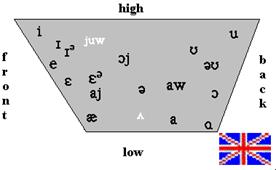
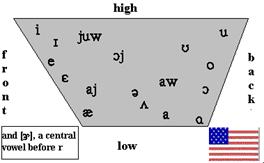
LITERATURE:
1) Васильев В.А. Фонетика англ.яз. Теоретический курс. – М.: Высшая школа, 1970 – с. 36-58.
2) Дикушина О.И. Фонетика английского языка. Теоретический курс. – М.: Просвещение, 1965. – С. 185-202.
3) Соколова М.А., Гинтовт К.П., Тихонова И.С., Тихонова Р.М. Теоретическая фонетика английского языка: Учеб.для студ.высш.уч.заведений. – 3-е изд., стереотип. – М.:Гуманит.изд.центр ВЛАДОС, 2003.- с.252-283.
----------------------------------------------------------------------------------------------
EXAMINATION QUESTIONS
1) Phonetics as a branch of linguistics. Phonetics and phonology.
2) Branches of phonetics. Methods of investigation.
3) The phoneme. Its aspects and functions.
4) I.A. Baudouin de Courteney’s views upon the phoneme.
5) L.V. Scerba's views upon the phoneme.
6) Ferdinand de Saussure's conception of the phoneme.
7) The Prague phonological school.
8) The London phonological school.
9) The American phonological school.
10) The Copenhagen phonological school.
11) Phonetic transcription. Different approaches to the problem.
12) The system of the English consonant phonemes, principles of classification.
13) The system of the English vowel phonemes, principles of classification.
14) Syllable formation. Theories of the syllable formation.
15) Functions of the syllable. Principles of syllable division.
16) Word-stress. Principles of word-stress formation
17) Accentual structure of English words. Functions of the word accent.
18) Intonation. Its functions. Intonation components: pitch, tempo, loudness.
19) Dialectology: national varieties of the language.
20) Pronunciation standard of British English. Received Pronunciation.
21) Northern English.
22) Welsh English
23) Scottish English.
24) The Eastern type of American English.
25) The Southern type of American English.
26) General American as contrasted with Received Pronunciation.
27) Modifications of consonants in connected speech.
28) Modifications of vowels in connected speech.
29) Speech organs and their functions.
30) Characteristics of speech sounds. Functions of speech sounds.
31) Practical application of phonetics. Phonetics and other sciences.
32) Typology of accentual structure of English words by G.P.Torsuev.
33) Basic rules of English word accentuation
34) Tones and scales, their formation and meanings.
35) Functions of language and functional styles.
36) Informational style
37) Academic style (Scientific).
38) Publicistic style (Oratorial).
39) Declamatory style (Artistic).
40) Conversational style (Familiar).Slang Register.
41) Assimilation, classification of assimilation.
42) Two forms of pronunciation (strong and weak forms), degrees of the reduction of strong forms.
43) The phenomena of accommodation and reduction.
LITERATURE FOR FURTHER READING:
1. Антипова Е.Я., Каневская С.Л., Пигулевская Г.А. Пособие по английской интонации (на англ.яз.) . – Л.,1974
2. Бубенникова О.А. Основные тенденции развития диалектов современного английского языка в области фонологии//Вестник МГУ. Сер.19.
3. Васильев В.А. Фонетика английского языка. Теоретический курс. (На англ.яз.). – М.,1970
4. Васильев В.А. и др. Фонетика английского языка. Нормативный курс (на англ.яз.). – М.,1980
5. Зиндер Л.Р. Общая фонетика. – М.,1979
6. Кузьменко Ю.К. Фонологическая эволюция германских языков. – Л.,1991
7. Леонтьева С.Ф. Теоретическая фонетика английского языка (на англ.яз.). – М., 1980
8. Маковский М.М. Английские социальные диалекты (онтология, структура, этимология). – М.,1982
9. Плоткин В.Я. Очерк диахронической фонологии английского языка. – М.,1976
10. Плоткин В.Я. Строй английского языка. – М., 1989
11. Селезнёв В.Х. Пособие по развитию навыков английской интонации. – М.,1983
12. Соколова М.А., Гинтовт К.П., Тихонова И.С., Тихонова Р.М. Теоретическая фонетика английского языка (на англ.яз.). – М.,1996
13. Трубецкой Н.С. Основы фонологии. – М.,1960
14. Швейцер А.Д. Истоки фонетических и грамматических особенностей американского варианта английского языка//Известия РАН. – 1994. - № 5. – С.30-45
15. Carr, Philip. English Phonetics and Phonology. An Introduction.: Blackwell Publishers,1999
16. Clark, John and Yallop, Colin. An Introduction to Phonetics and Phonology. Series: Blackwell Textbooks in Linguistics, 1995
17. Johnson, Keith. Acoustic and Auditory Phonetics: Blackwell Publishers, 1996
18. Lyons J. Introduction to Theoretical Linguistics. – Cambridge, 1969
19. Mills C. American Grammar. Sound, form, and meaning/American Univ. Studies. Series XIII. – N.Y., 1990
20. Phonological Theory. The Essential Readings/Ed. By John A.Goldsmith. Series: Linguistics: The Essential Readings,1999
21. Phonology. Critical Concepts in Linguistics/Ed. Charles W.Kreidler.: Routledge,2000
22. Spencer, Andrew. Phonology. Theory and Description. Series: Introducing Linguistics.: Blackwell Publishers,1995
23. Yule G. The Study of Language. An Introduction. – Cambridge: Univ.Press, 1985
APPENDICIS
APPENDIX 1.
LIST OF STRONG AND WEAK FORMS
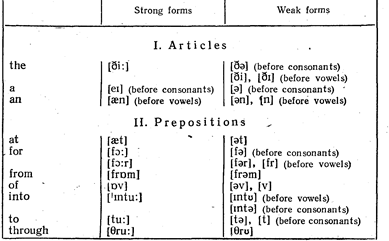
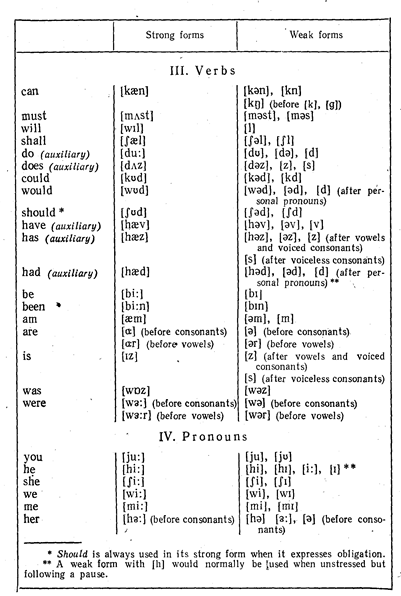
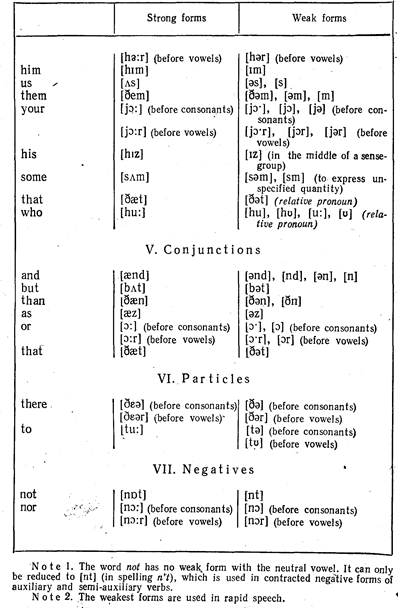
APPENDIX 2. R. KINGDON’S TONETIC STRESS-MARK SYSTEM
Tones:
a) The Low Fall.

b) The High Wide Fall.

c) The High Narrow Fall.

d) The Low Rise.

e) The High Narrow Rise.

f) The High Wide Rise.

g) The Rise-Fall.

h) The Fall-Rise.

i) The Rise-Fall-Rise.

j) The Level Tones
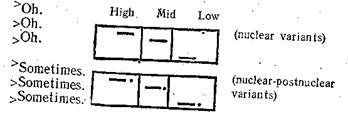
Scales:
a. The Descending Stepping Scale


Upbroken Descending Scale:

Broken Descending Scale:

b. The Descending Sliding Scale
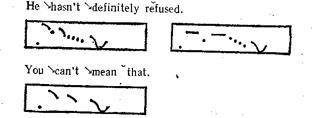
c. The Descending Scandent Stale

d. The Ascending Stepping Scale


e. The Ascending Sliding Scale

f. The Ascending Scandent Scale:

g. A Level Scale
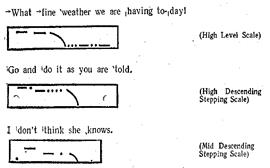

Heads:
1) inferior

2) superior

3) scandent

Tails:
1) descending

2) level:
 or
or 
3) ascending:
 ,
, 
APPENDIX 3. TERRITORRIAL VARIETIES OF THE ENGLISH LANGUAGE.
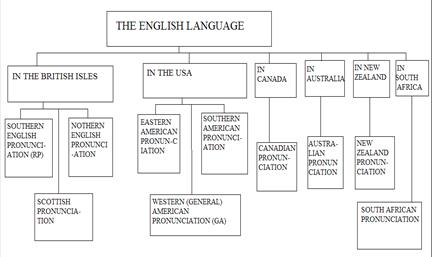
BRITISH ENGLISH ACCENTS
| English English | Welsh English | Scottish English | Northern Ireland English |
| Southern | Northern | Educated Scottish English | Regional Varieties |
| 1. Southern 2. East Anglia 3. South-West | 1. Northern 2. Yorkshire 3.North-West 4. West-Midland |
APPENDIX 4.
PHONETIC VOCABULARY.
А
accentударение; акцент
accentual nucleusпоследнее фразовое ударение» несущее мелодическое завершение
accentual types of wordsакцентные типы слов
accentuation (word accentuation)словесное ударение .
accidental assimilationслучайная ассимиляция
accommodationаккомодация, приспособление
acousticallyакустически
acoustically closestакустически наиболее близкий (похожий)
actionдействие; зд. движение органов речи
adaptationадаптация
affricateаффриката
affricativeаффрикативный
air-passageпроход для воздуха
air-streamпоток воздуха
allophoneаллофон (вариант, оттенок фонемы)
allophonicаллофонный (аллофонический)
alveolarальвеолярный
alveoliальвеолы
apicalапикальный
articulateартикулировать (о звуках речи)
articulationартикуляция, образование
articulatorартикулирующий орган (о звуке речи)
articulatoryартикуляторный
ascending scale восходящая шкала
aspirated произносимый с придыханием
aspirationаспирация, придыхание
assimilateассимилировать, уподоблять
assimilationассимиляция, уподобление
attitudinal coloring (of the utterance)выражение отношения говорящего (в высказывании)
attitudinally distinctive functionфункция различения отношений
audible слышимый (о шуме)
auditoryслуховой
В
back-advanced vowelгласный задне-продвинутого вперед ряда
backlingualзаднеязычный
back of the tongueзадняя часть языка
back vowelгласный заднего ряда
back wall of the pharynx задняя стенка зева
bilabialбилабиальный, губно-губной, двугубный (напр.согласные [п], [б] и т. п.)
blade of the tongueпередняя спинка языка ,
broad variationширокая разновидность подъема части языка (о гласных)
broken descending scaleнарушенная нисходящая шкала
bulkof the tongueтело (масса) языка
С
cacuminalкакуминальный
central vowelsгласные среднего ряда
checkedзд. усеченный (гласный)
close vowelзакрытый гласный, гласный высокого подъема части языка
closed syllableзакрытый слог
clusterсочетание согласных звуков
coarticulationко-артикуляция, совместная (дополнительная), артикуляция
cognateродственный, сходный (звук)
coloringокраска (голоса), оттенок
communicationсообщение
communicative centreкоммуникативный центр
communicative typeкоммуникативный тип (о предложении)
communicatively distinctive functionкоммуникативно-различительная функция
complete assimilationполная ассимиляция
complex toneсложный тон
componentсоставная часть, компонент
consonant согласный
constrictiveщелевой
contactсоприкосновение, смыкание
contextual assimilation действующая ассимиляция
continuantдлительный согласный.
contourрисунок (о мелодии)
contour of intonationинтонационный рисунок
contractedсокращенный
counterpartсоответствие (звуковое) .
curveкривая (линия)
D
defineопределять, давать определение
definitionопределение
dentalдентальный, зубной
descending scaleнисходящая шкала
devoiceоглушать
devoicedоглушенный
devoicingоглушение
diagnoseопределять (об ошибках в произношении)
diagnosisдиагноз; зд. определение (характера ошибки в произношении)
differentiateразличать (слова)
diphthongдифтонг
diphthongalдифтонгический
diphthongizedдифтонгизированный
diphthongoidдифтонгоид
discriminate(between) зд. слышать различия (между)
distinctive featureразличительный (фонологический) признак
disyllabicдвусложный
dorsalдорсальный
durationдлительность
E
ear-trainingтренировка слуха
elisionвыпадение (звука)
emotional coloringэмоциональная окраска
emphasisвыразительность, подчеркивание, эмфаза
emphasizeподчеркивать, делать особое ударение (на слове)
emphaticвыразительный, эмфатический, подчеркнутый
epiglottisнадгортанник
established assimilationобщепринятая ассимиляция
exclamationвосклицание
exhalationвыдыхание, выдох
F
facultativeфакультативный, необязательный
fallingнисходящий (о тоне)
falling diphthong нисходящий (падающий) дифтонг
fall-riseнисходяще-восходящий тон
finalконечный; ад. находящийся на конце слова
fixedнеподвижный, пассивный
flat narrowingплоская щель
fore- and mediolingualпередне-среднеязычный
forelingualпереднеязычный
form-wordслужебное слово
fortisсильный
fricativeфрикативный
frictionшум трения
front of the tongueсредняя часть языка
front-retracted vowelгласный передне-отодвинутого назад ряда
front vowelгласный переднего ряда
G
general questionобщий вопрос
glideскольжение (глайд), призвук
glottalгортанный
glottal stopгортанный взрывной звук
glottisголосовая щель
groove-likeв виде желобка
gross mistake грубая ошибка
H
hard palateтвердое нёбо
head (of the scale)первый ударный слог
hiatusзияние; сочетание двух гласных букв, передающих два гласных звука
high-broadширокая разновидность высокого подъема языка
high-narrowузкая разновидность высокого подъема языка
high narrow fallвысокий нисходящий тон узкого диапазона
high narrow riseвысокий восходящий тон узкого диапазона
high vowelгласный высокого подъема (части языка)
high wide fallвысокий нисходящий тон широкого диапазона
high wide riseвысокий восходящий тон широкого диапазона
historical assimilationисторическая ассимиляция
I
implicationто, что подразумевается; подтекст
implicatory statementутверждение с подтекстом
implyподразумевать
initialначальный (о положении, позиции)
insinuating statementпредложение, содержащее намек
insistent настоятельный (о просьбе, требовании)
intensifierусилитель (значения слова)
intensity emphasisэмфаза для усиления, выделения слова или выражения
interdental межзубный
intermediateпромежуточный
intermediate assimilationпромежуточная ассимиляция
interpenetrationвзаимопроникновение
intervocalicинтервокальный
intonationинтонация
intonation groupинтонационная группа
J
jawчелюсть
junctionстык (о словах); соединение (о звуках речи)
L
labialгубной
labio-dentalгубно-зубной
larynxгортань
lateralбоковой, латеральный
lateral plosionбоковой взрыв
laxненапряженный
length] долгота
lenisслабый
level scaleровная шкала
level toneровный тон
likable положительный (об эмоциях, отношениях)
lingualязычный
lip-protrusionвыдвижение губ вперед
lip-roundingлабиализация, огубление
logical stressлогическое ударение
long vowelдолгий гласный
low-broadширокая разновидность низкого подъема языка
lower jawнижняя челюсть
low fallнизкий нисходящий тон (нисходящий тон, начинающийся со среднего или низкого уровня) „
low-narrowузкая разновидность низкого подъема языка
low riseнизкий восходящий тон
low vowel гласный низкого подъема (части языка)
lungsлегкие
М
manner of the production of noise способ образования шума
medianсрединный
medium tongue positionсредний подъем языка
mediolingualсреднеязычный .
mergingслияние (о фазах артикуляции звука)
mid-broadширокая разновидность среднего подъема языка
middle of the tongueсредняя часть языка
mid-narrowузкая разновидность среднего подъема языка
mid-open vowelгласный среднего подъема (языка)
mid vowelгласный среднего подъема (языка)
mispronounceпроизносить неправильно
mixedсмешанный
monophthongмонофтонг, простой гласный
monosyllabicодносложный
morphemeморфема
mother tongueродной язык (как средство общения)
mouth cavityротовая полость
mouth openingротовое отверстие
movableподвижный, активный
moving toneизменяющийся тон
musclesмускулы
muscular tensionмускульное, мышечное напряжение
N
narrowingсужение; щель
narrow variationузкая разновидность подъема части языка (о гласных)
nasalносовой
nasal cavityносовая полость
nasal plosionносовой взрыв
neutralнейтральный
noiseшум, шумный
noise consonantшумный согласный
non-aspiratedпроизносимый без придыхания
non-distinctiveнефонологический (признак звука)
non-finalнеконечная (синтагма)
non-neutralненейтральный
non-palatalizedнепалатализованный, несмягченный
non-phonemicнефонематический, нефонематичный
non-phonologicalнефонологический
normative courseнормативный курс
notional wordзнаменательное слово
nuclearядерный
nucleiядра
nucleusядро
obstructionпреграда
occlusiveсмычный
off-glideрекурсия, конечная фаза (звука)
one-word communicative centreоднословный коммуникативный центр
on-glideэкскурсия, начальная фаза (звука)
onsetначало, приступ (звука)
open syllableоткрытый слог
open vowelоткрытый гласный (гласный низкого подъема части языка)
oralртовый
organs of speechорганы речи
Р
palatalпалатальный, нёбный
palatalizationпалатализация, смягчение
palatalizeпалатализовать, смягчать
palatalizedпалатализованный, смягченный (о согласном звуке)
palatalizingпалатализующий, смягчающий
palateнёбо
palato-alveolarнёбно-альвеолярный
partial assimilationчастичная ассимиляция
pharyngalфарингальный
pharynxзев, фаринке
phonemeфонема
phonemicфонематический
phoneticфонетический
phonetic contextфонетическое (звуковое) окружение
phonetic lawфонетический закон
phonetic system of a languageфонетический (звуковой) строй языка
phoneticsфонетика
phonologicalфонологический
phonologyфонология
pitchвысота (голосового) она
pitch componentмелодический компонент интонации
pitch levelвысотный уровень (уровень высоты тона)
pitch movementмелодическое движение, движение высоты тона голоса
pitch rangeдиапазон высоты тона голоса
plosionвзрыв
plosionlessбезвзрывный (о варианте фонемы)
plosiveвзрывной (напр., согласные [б], [к])
point of articulationместо артикуляции
positionalпозиционный (о долготе)
post-alveolarзаальвеолярный
post-dentalзазубный
posttonicзаударный, послеударный
pre-headначальные безударные слоги, предшествующие первому ударному слогу
pre-nuclear primary accentпредъядерные главные ударения
pre-vocalicнаходящийся перед гласным
pretonicпредударный
prevention of mistakesпредупреждение (профилактика) ошибок
primary stressглавное ударение
principalглавный, основной (принцип)
progressive assimilationпрогрессивная ассимиляция
prominenceусиление, подчеркивание
prominentусиленный, подчеркнутый, выделяющийся
protruded вытянутые вперед (о губах)
puff (of air, breath)короткий, быстрый выдох
Q
qualitativeкачественный
quantitativeколичественный
question tag вопросительная фраза (в разъединительном вопросе)
R
rangeдиапазон
rateскорость
reciprocal assimilationвзаимная ассимиляция
recurrenceповторение
reducedредуцированный
reductionредукция
regressive assimilationрегрессивная ассимиляция
releaseразмыкать, устранять преграду (при образовании звука)
resonance-chamberрезонатор, полость резонатора
resonatorрезонатор
retention stageвыдержка, вторая фаза (о звуке)
retroflexретрофлексный
rhythmритм
rhythmicgroup ритмическая группа
rhythmicalритмический
rise-fallвосходяще-нисходящий тон
risingвосходящий (о тоне)
rise-fall-rise восходяще-нисходяще-восходящий сложный тон
rolledдрожащий, вибрант (о звуке [р])
roof of the mouthнёбо
root of the tongueкорень языка
roundокруглять (о губах)
round narrowingкруглая щель
rounded vowelлабиализованный (огубленный) гласный
RP (Received Pronunciation)литературное английское произношение
S
scaleшкала (мелодическая)
scandent scaleшкала с восходящими неударными слогами
secondary stressвторостепенное ударение
sense-groupсинтагма, смысловая группа
sentence-final positionконечное положение в предложении
sentence-initial positionначальное положение в предложении
sentence-medial positionсрединное положение в предложении
sentence-stressфразовое ударение
sequence of tonesпоследовательность тонов
shapeформа
short vowelкраткий гласный
slanting наклонный, косой
sliding scaleскользящая шкала
slit щель
soft palateмягкое нёбо
sonorantсонант
sonorityсонорность, звучность
sonorousзвучный
special questionспециальный вопрос (начинающийся с вопросительного слова) speech melodyмелодика речи
speech organорган речи
speech-soundзвук речи
spoonshaped depressionложкообразная впадина
spreadрастягивать (о губах)
staves две параллельные линии, принятые для обозначения верхнего и нижнего пределов голосового диапазона
stopвзрывной согласный
stop-stageвыдержка, вторая фаза (о смычных согласных)
stressударение (в cлове, предложении)
stressedударный
strong formсильная форма
subsidiaryвторостепенный
syllabicслоговой, слогообразующий
syllableслог
syllable divisionслогоделение
syllable final/ initialнаходящийся в конце (в начале) слога
syllable formationслогообразование
Т
tailбезударная часть терминального тона, следующая за ядром
tamberтембр
teeth-ridgeальвеолы
tempoтемп
temporalвременной (компонент)
tenseнапряженный
tenseness напряженность
tension (muscular)мускульное напряжение
terminal (tone)терминальный тон, мелодическое завершение (синтагмы, предложения)
tip of the tongueкончик языка
tonalityтональность
toneтон
tonetic stress marksтонетические знаки ударения (знаки ударения, одновременно обозначающие и мелодику)
tongueязык (как орган речи)
tongue-back-(front-) coarticulationартикуляция со вторым задним (передним) фокусом
transcriptionтранскрипция
trilledдрожащий (о согласном [р])
U
uncheckedнеусеченный
unemphaticнеэмфатический
unrounded vowelнелабиализованный (неогубленный) гласный
unstressedнеударный
upper lipверхняя губа
upper teethверхние зубы
utterиздавать (о звуке), произносить
utteranceвысказывание
uvulaмаленький язычок
V
variantвариант, оттенок
variationразновидность
velarвелярный, задненёбный
velumмягкое нёбо
verbal contextописанная словами ситуация
vibrateвибрировать
vibrationвибрация, дрожание, колебание
vocal cordsголосовые связки
voiceозвончать; голос
voicedзвонкий, произносимый с голосом (о звуке речи)
voiced consonantзвонкий согласный
voiceless глухой (о таких согласных, как [ф], [к] и т. п.)
volumeобъем
vowelгласный
vowel durationдлительность гласного (позиционная)
W
weak formслабая форма
windpipeдыхательное горло
word-final/initialнаходящийся в конце (в начале) слова
word-final position конечное положение в слове
word-group communicative centreмногословный коммуникативный центр
word-stressсловесное ударение
Z
zero reduction нулевая редукция
APPENDIX 5. LIST OF PHONETIC SYMBOLS AND SIGNS.
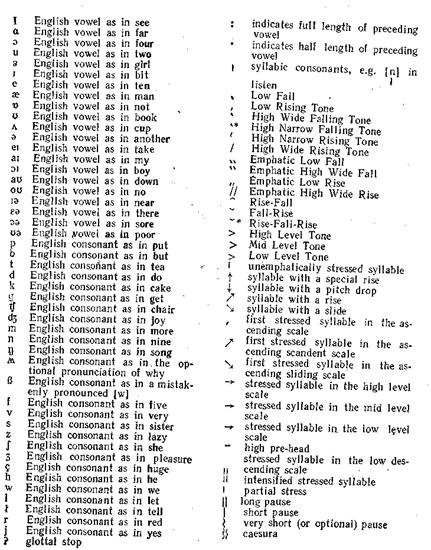
CONTENTS
General information………………………………………………………....2
Outline of Lectures………………………………………………………......3
LECTURE 1. Phonetics as a branch of linguistics. Introductory lecture…....3
LECTURE 2. The phoneme………………………………………………....6
LECTURE 3. The system of English consonant phonemes…………………9
LECTURE 4. The system of English vowel phonemes…………………….13
LECTURES 5. Syllabic structure of English words………………………..16
LECTURES 6. Word stress………………………………………………...19
LECTURES 7. Intonation…………………………………………………..21
LECTURE 8. Stylistic varieties of English………………………………...24
LECTURE 9. Territorial varieties of English pronunciation……………….26
Outline of seminars…………………………………………………………32
SEMINAR 1. ARTICULATION OF ENGLISH CONSONANT AND VOWELS PHONEMES…………………………………………………….32
Topics for reports…………………………………………………………...32
Home practice………………………………………………………………32
Questions for self study……………………………………………………..35
Literature……………………………………………………………………39
SEMINAR 2. MODIFICATIONS OF CONSONANTS AND VOWELS IN CONNECTED SPEECH……………………………………………………39
Topics for reports…………………………………………………………...39
Home practice………………………………………………………………40
Questions for self study…………………………………………………….43
Literature……………………………………………………………………48
SEMINAR 3. THE PHONEME THEORIES………………………………48
Topics for reports…………………………………………………………...48
Home practice………………………………………………………………49
Questions for self study…………………………………………………….49
Literature……………………………………………………………………54
SEMINAR 4. SYLLABLE FORMATION AND SYLLABLE
DIVISION…………………………………………………………………..54
Topics for reports…………………………………………………………...54
Home practice………………………………………………………………55
Questions for self study…………………………………………………….55
Literature……………………………………………………………………56
SEMINAR 5. THE ACCENTUAL STRUCTURE OF ENGLISH
WORDS…………………………………………………………………….57
Topics for reports…………………………………………………………..57
Home practice……………………………………………………………...57
Questions for self study……………………………………………………58
Literature…………………………………………………………………...58
SEMINAR 6. INTONATION……………………………………………………………...59
Topics for reports…………………………………………………………...59
Home practice………………………………………………………………59
Questions for self study…………………………………………………….64
Literature……………………………………………………………………69
SEMINAR 7. FUNCTIONAL STYLES OF ENGLISH………………………..69
Topics for reports…………………………………………………………...69
Home practice………………………………………………………………70
Questions for self study…………………………………………………….72
Literature……………………………………………………………………72
SEMINAR 8. TERRITORIAL VARIETIES OF THE ENGLISH LANGUAGE………………………………………………………………..73
Topics for reports…………………………………………………………...73
Home practice………………………………………………………………73
Questions for self study…………………………………………………….75
Literature……………………………………………………………………77
EXAMINATION QUESTIONS…………………………………………….78
LITERATURE FOR FURTHER READING……………………………….79
APPENDICIS………………………………………………………………..80
APPENDIX 1. List of strong and weak forms………………………………80
APPENDIX 2. R. Kingdon’s tonetic stress-mark system…………………...83
APPENDIX 3. Territorial varieties of English……………………………....87
APPENDIX 4. Phonetic vocabulary…………………………………………88
APPENDIX 5. List of phonetic symbols and signs………………………….98
CONTENTS………………………………………………………………….99
